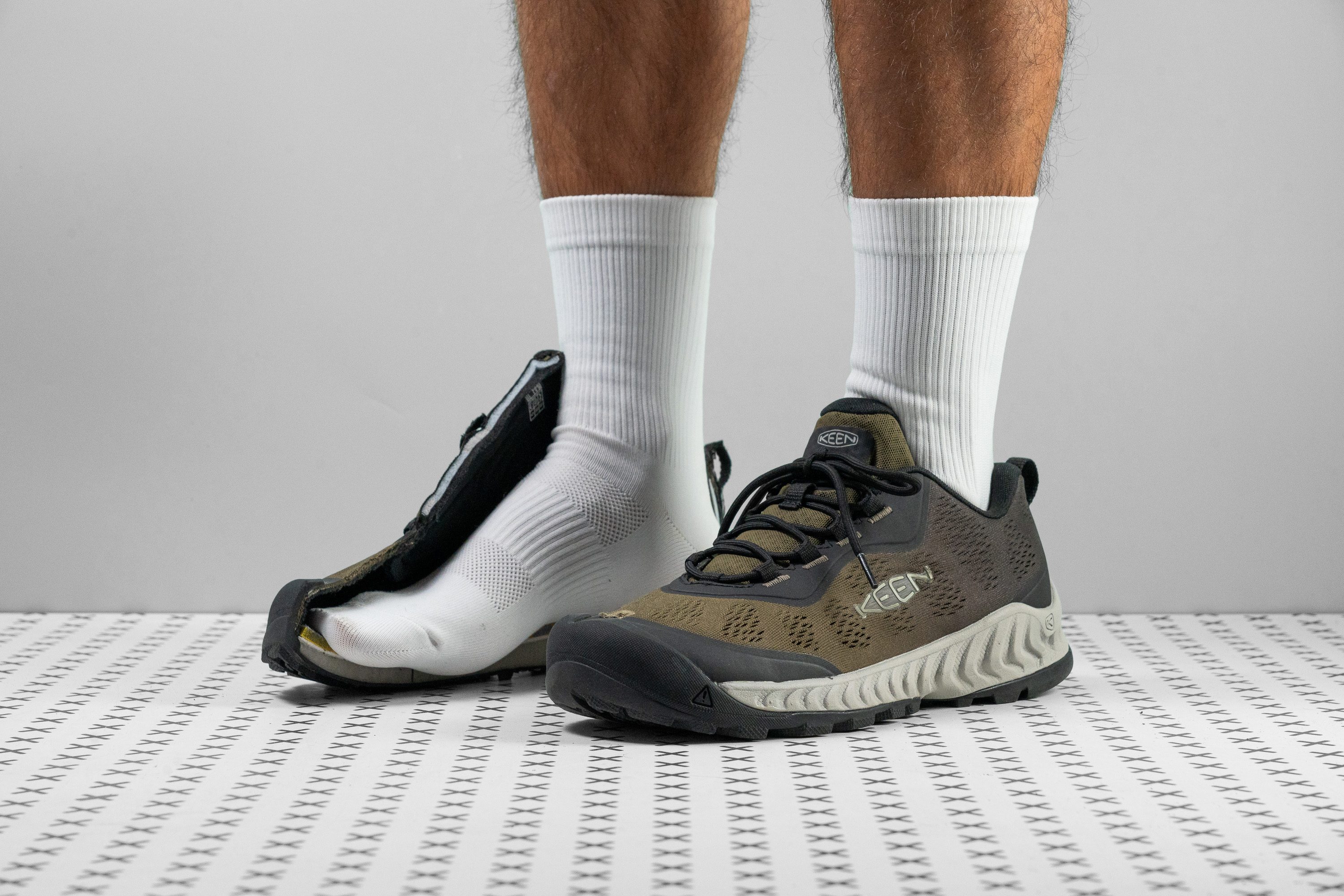Our verdict
- Top pick in best hiking shoes with a wide toebox (2024)
- Top pick in best summer hiking shoes (2024)
Pros
- Top-level comfort
- Immensely breathable
- Sticks to various terrain
- Extremely durable outsole
- Quite lightweight
- Incredible support
- Relaxed forefoot fit
- Accommodating toebox
- Greatly flexible
- Locks the heel in place
Cons
- Unruly shoestrings
- Too airy for cold winters
- Not ideal for backpacking
Audience verdict
Comparison
The most similar hiking shoes compared
+ + Add a shoe | |||||
|---|---|---|---|---|---|
| Audience score | 84 Good! | 88 Great! | 89 Great! | 87 Great! | |
| Price | £150 | £125 | £110 | £90 | |
| Trail terrain | ModerateTechnical | Moderate | Technical | Moderate | |
| Shock absorption | - | High | Low | Moderate | |
| Energy return | - | Low | Moderate | Moderate | |
| Weight lab Weight brand | 11.8 oz / 335g 12 oz / 340g | 11.6 oz / 329g 12.3 oz / 350g | 15.3 oz / 434g 16.2 oz / 460g | 13.4 oz / 379g 13.4 oz / 379g | |
| Lightweight | ✓ | ✓ | ✗ | ✓ | |
| Breathability | Breathable | Breathable | Breathable | Moderate | |
| Use | Day HikingSpeed Hiking | Day HikingSpeed HikingLight Hiking | Day HikingBeginners | Day HikingSpeed HikingLight HikingBeginners | |
| Orthotic friendly | ✓ | ✓ | ✓ | ✓ | |
| Drop lab | 10.4 mm | 15.0 mm | 11.2 mm | 9.7 mm | |
| Size | True to size | Half size small | True to size | Slightly small | |
| Midsole softness | Soft | Soft | Firm | Firm | |
| Difference in midsole softness in cold | Small | Normal | Normal | Big | |
| Torsional rigidity | Flexible | Stiff | Moderate | Stiff | |
| Heel counter stiffness | Stiff | Flexible | Flexible | Stiff | |
| Stiffness | Moderate | Moderate | Flexible | Flexible | |
| Outsole hardness | Average | Average | Average | Average | |
| Waterproofing | Water repellent | - | - | Water repellent | |
| Material | Mesh | Mesh | LeatherMesh | Mesh | |
| Season | SummerAll seasons | SummerAll seasons | SummerAll seasons | All seasons | |
| Toebox durability | Good | Very good | - | - | |
| Heel padding durability | Bad | Bad | - | - | |
| Outsole durability | Good | Good | - | - | |
| Width / fit | Medium | Medium | Medium | Medium | |
| Toebox width | Wide | Wide | Medium | Narrow | |
| Lug depth | 4.0 mm | 3.7 mm | 4.8 mm | 3.7 mm | |
| Heel stack lab | 30.7 mm | 38.8 mm | 31.7 mm | 30.6 mm | |
| Forefoot | 20.3 mm | 23.8 mm | 20.5 mm | 20.9 mm | |
| Widths available | Normal | NormalWide | NormalWide | NormalWide | |
| Technology | - | - | Vibram | - | |
| Heel tab | Finger loop | Finger loop | Finger loop | None | |
| Removable insole | ✓ | ✓ | ✓ | ✓ | |
| Ranking | #22 Bottom 37% | #9 Top 26% | #7 Top 20% | #10 Top 29% | |
| Popularity | #30 Bottom 14% | #6 Top 18% | #1 Top 3% | #16 Top 46% |
Who should buy
We recommend the Keen NXIS Speed as a great option for:
- Hikers who prioritise comfort looking for a generously padded and well-cushioned shoe
- Those living in warmer climates in need of an airy, well-ventilated shoe to avoid stuffy and stinky feet
- Experienced hikers in the market for a lightweight and agile shoe for tearing swiftly across the trails
- Hikers with a preference for flexible shoes that still provide good stability and support underfoot.
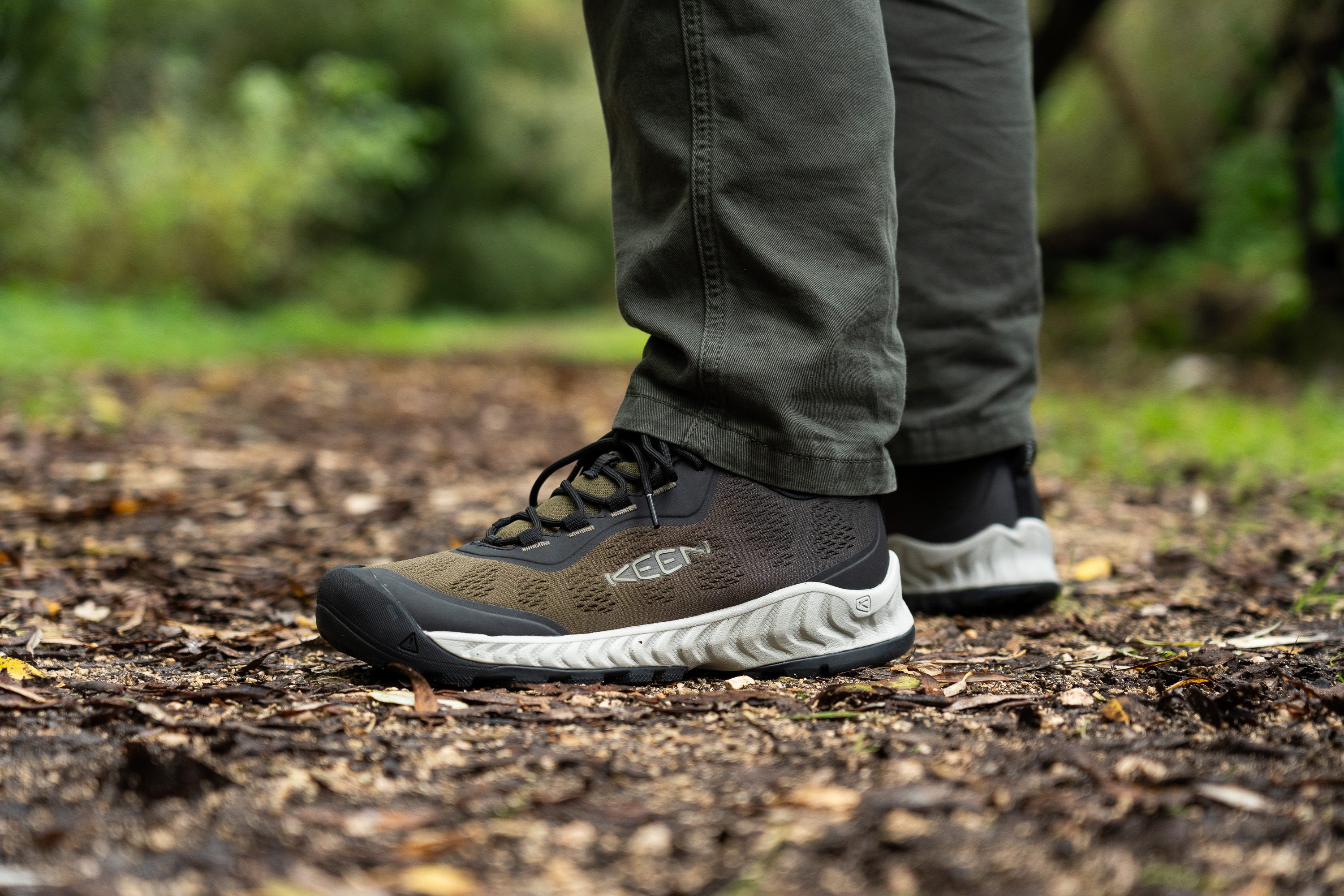
Who should NOT buy
The NXIS Speed's plush midsole isn't ideal for schlepping heavy payloads across long distances. we recommend a firmer option like the similarly lightweight Adidas Terrex Trailmaker instead for those multi-day hikes.
Despite performing quite well in our freezer tests, the NXIS Speed is definitely more of a fair-weather friend. For those planning arduous winter expeditions, we recommend the truly weatherproof Salomon X Ultra 4 GTX instead.
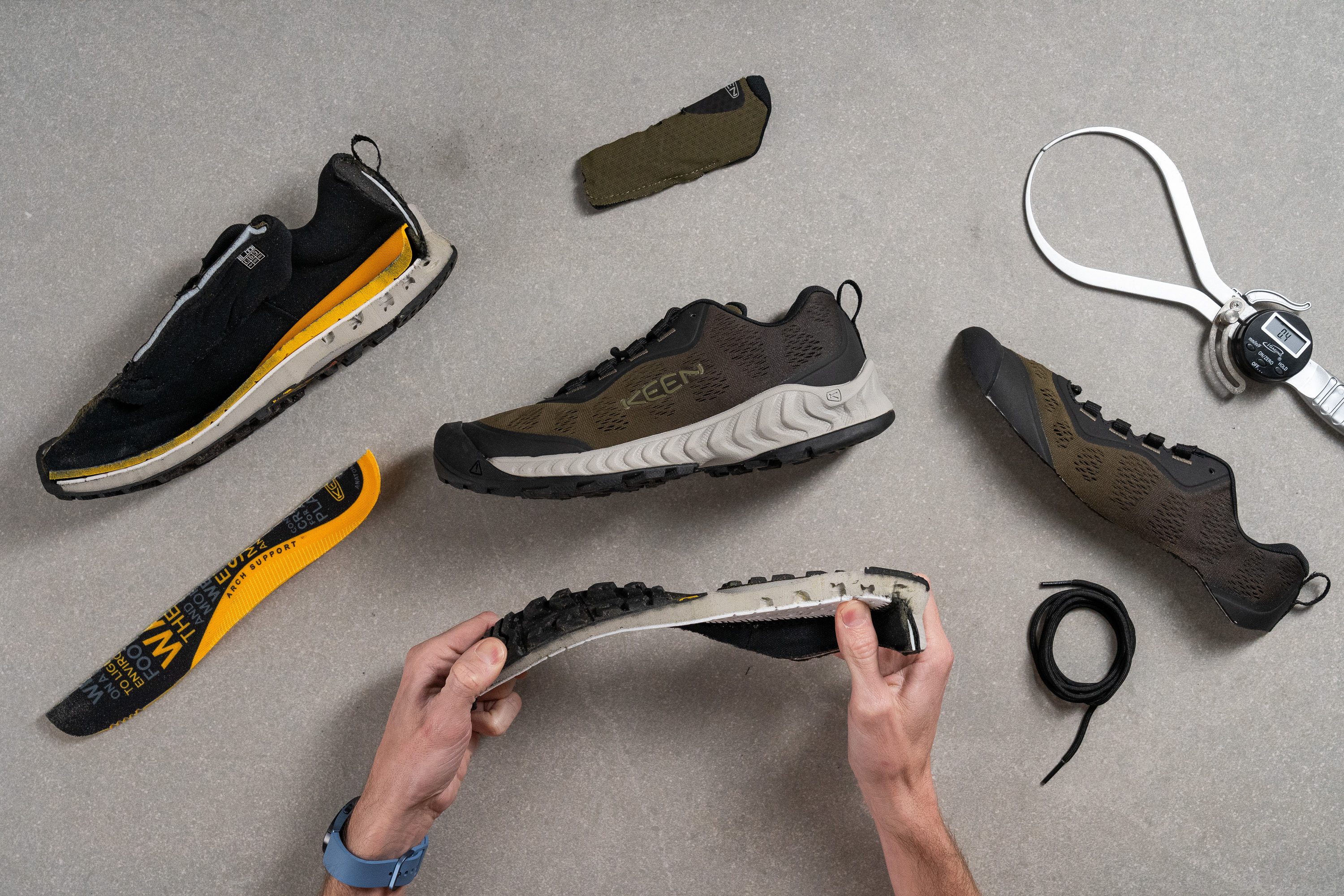
While this may come off as more of a nitpick, the NXIS Speed's finicky default laces were probably the biggest frustration we had to contend with while testing the shoe. This can be solved either by replacing them or considering the more secure Salomon Outpulse instead.
Cushioning
Heel stack
We measured the NXIS Speed's stack with our caliper to be 30.4 mm thick at the heel. This is right on par with our current lab average, giving us a healthy amount of foam underfoot to adequately dampen our landings and keep us feeling safe from any hazards below.
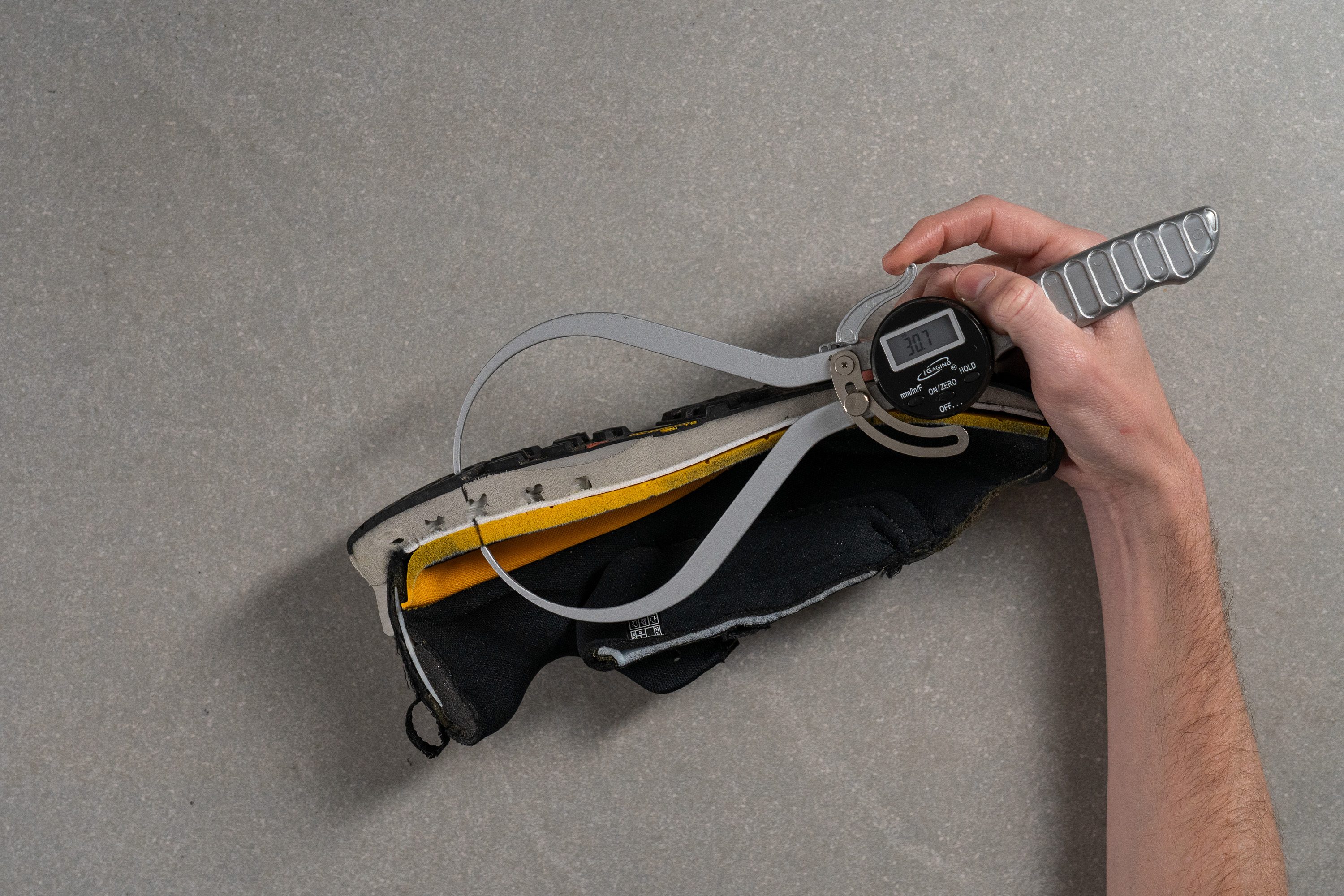
| NXIS Speed | 30.7 mm |
| Average | 32.8 mm |
Forefoot stack
The NXIS Speed's stack also falls in line with our current lab average at the forefoot at 20.3 mm thick according to our caliper measurements. This gives us enough foam to feel well-cushioned while still providing a good level of ground feel which allows us to nimbly and intuitively navigate the trails.

| NXIS Speed | 20.3 mm |
| Average | 22.0 mm |
Drop
With a 10.4 mm offset in its stack, the NXIS Speed shouldn't feel too different from the average hiking shoe.

| NXIS Speed | 10.4 mm |
| Average | 10.7 mm |
Midsole softness
We pressed our durometer against the NXIS Speed's midsole and got a softer-than-average reading of 20.9 HA.

This level of softness provides us with incredibly well-cushioned landings and keeps our feet feeling fresh and easy even during our longer and more gruelling test hikes.
On the other hand, we don't recommend this shoe for extended backpacking trips as lugging heavy loads with such a soft midsole underfoot can lead to foot fatigue and imbalance over time. For a shoe with a firmer midsole that's more conducive to being a beast of burden, check out the Adidas Terrex Trailmaker as an alternative.
| NXIS Speed | 20.9 HA |
| Average | 27.0 HA |
Size and fit
Size
KEEN NXIS Speed fits true to size (27 votes).
Width / Fit
We measured the NXIS Speed's toebox to be 103 mm wide at its widest point. This is slightly roomier than average and means that the shoe should accommodate most foot shapes comfortably while still providing a secure fit. Only those with very broad feet might experience hotspots during longer hikes as the feet start to sell up from repeated impact.
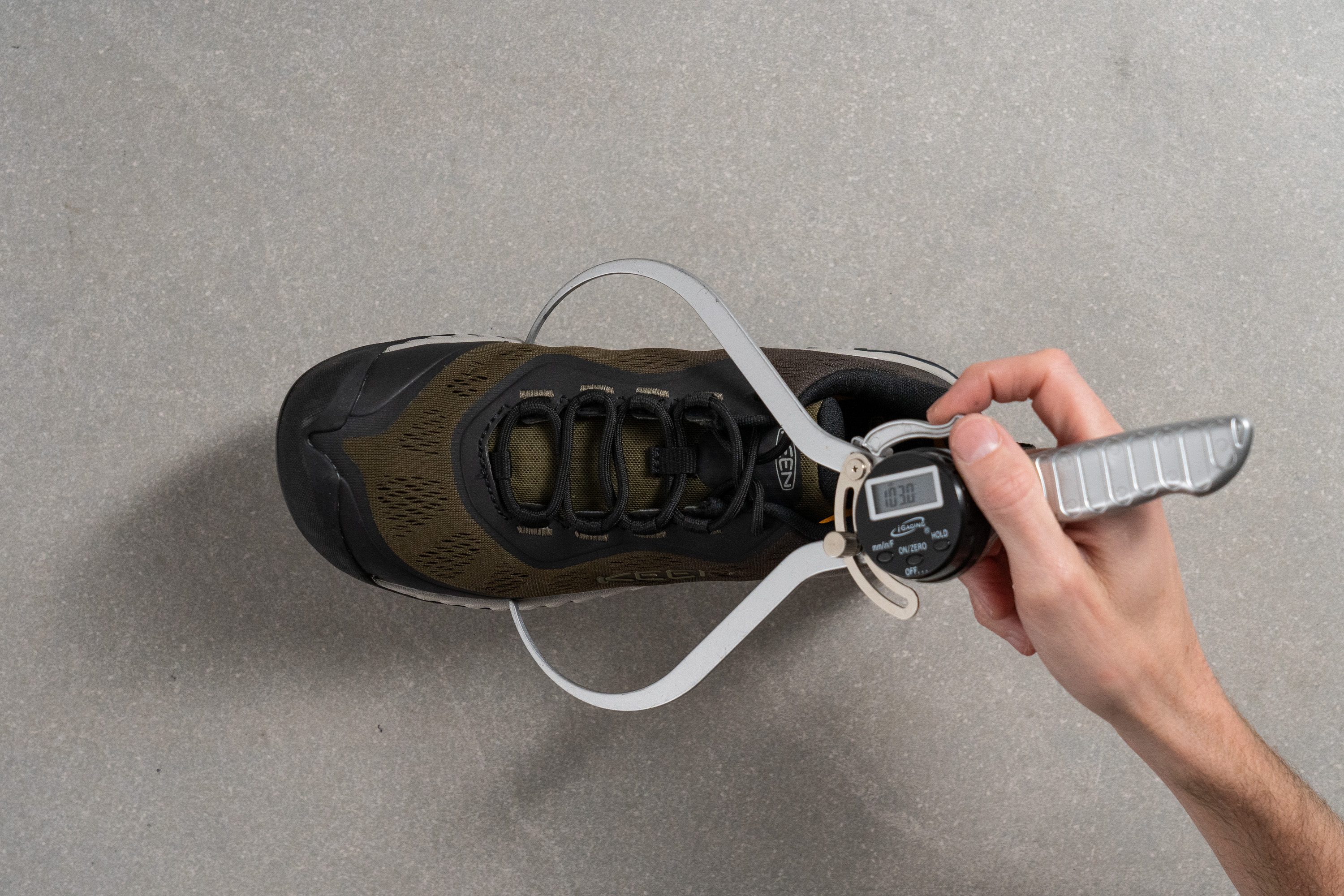
This test follows an older methodology, which is why you don't see recently tested shoes in the chart. Results from different methodologies can not be compared.
| NXIS Speed | 103.0 mm |
| Average | 100.5 mm |
Toebox width
The NXIS Speed's toebox doesn't taper as much as the average hiking shoe does at 89.6 mm wide in the area around the big toe. This is much wider than our current lab average and gives the NXIS Speed a more natural foot-shaped silhouette that gives us plenty of real estate for our toes to splay our comfortably during our test hikes.
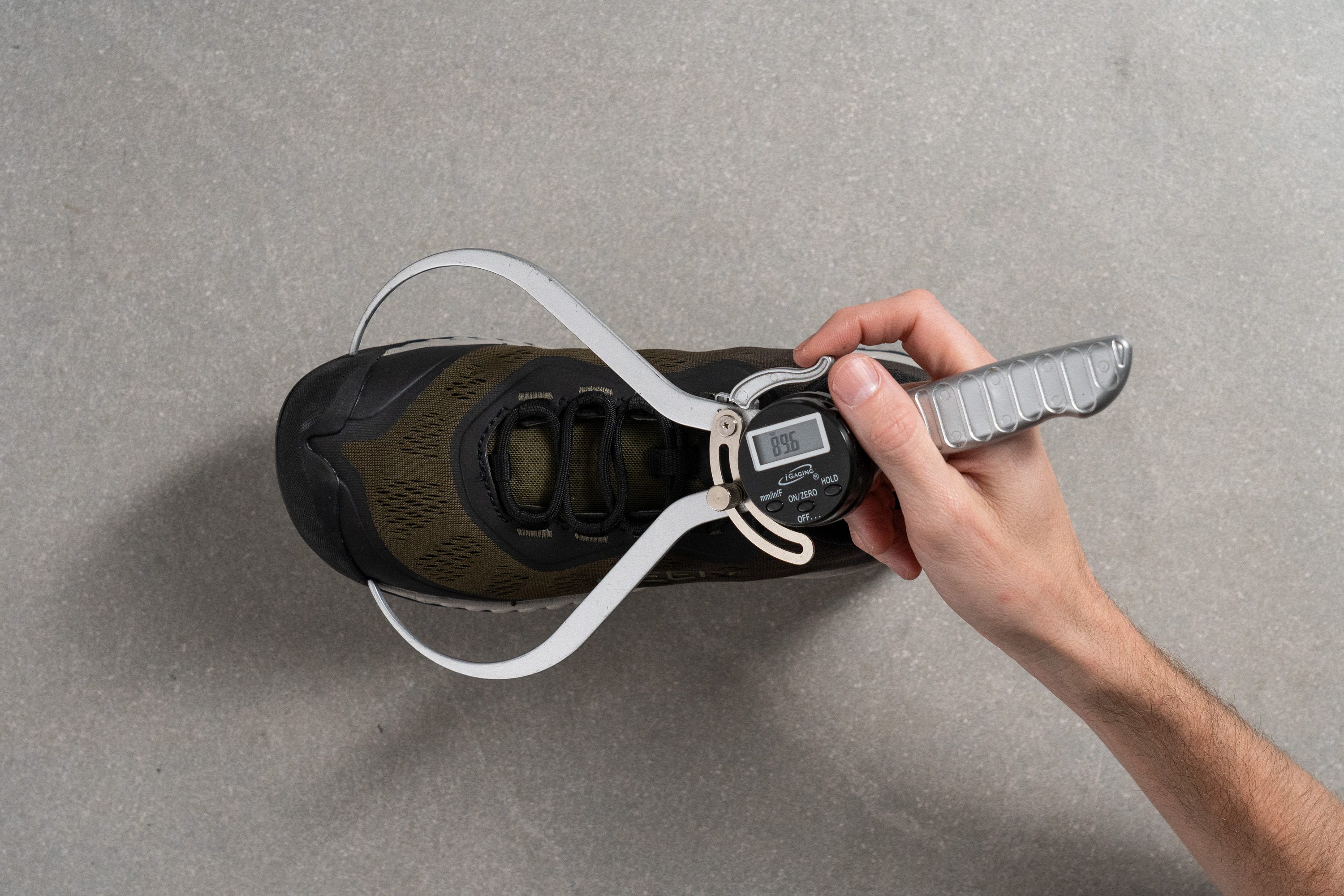
This test follows an older methodology, which is why you don't see recently tested shoes in the chart. Results from different methodologies can not be compared.
| NXIS Speed | 89.6 mm |
| Average | 81.0 mm |
Traction / Grip
Lug depth
Using our calliper, we measured the NXIS Speed's multi-directional, chevron-shaped lugs to be 4 mm thick, putting them on par with our current lab average.
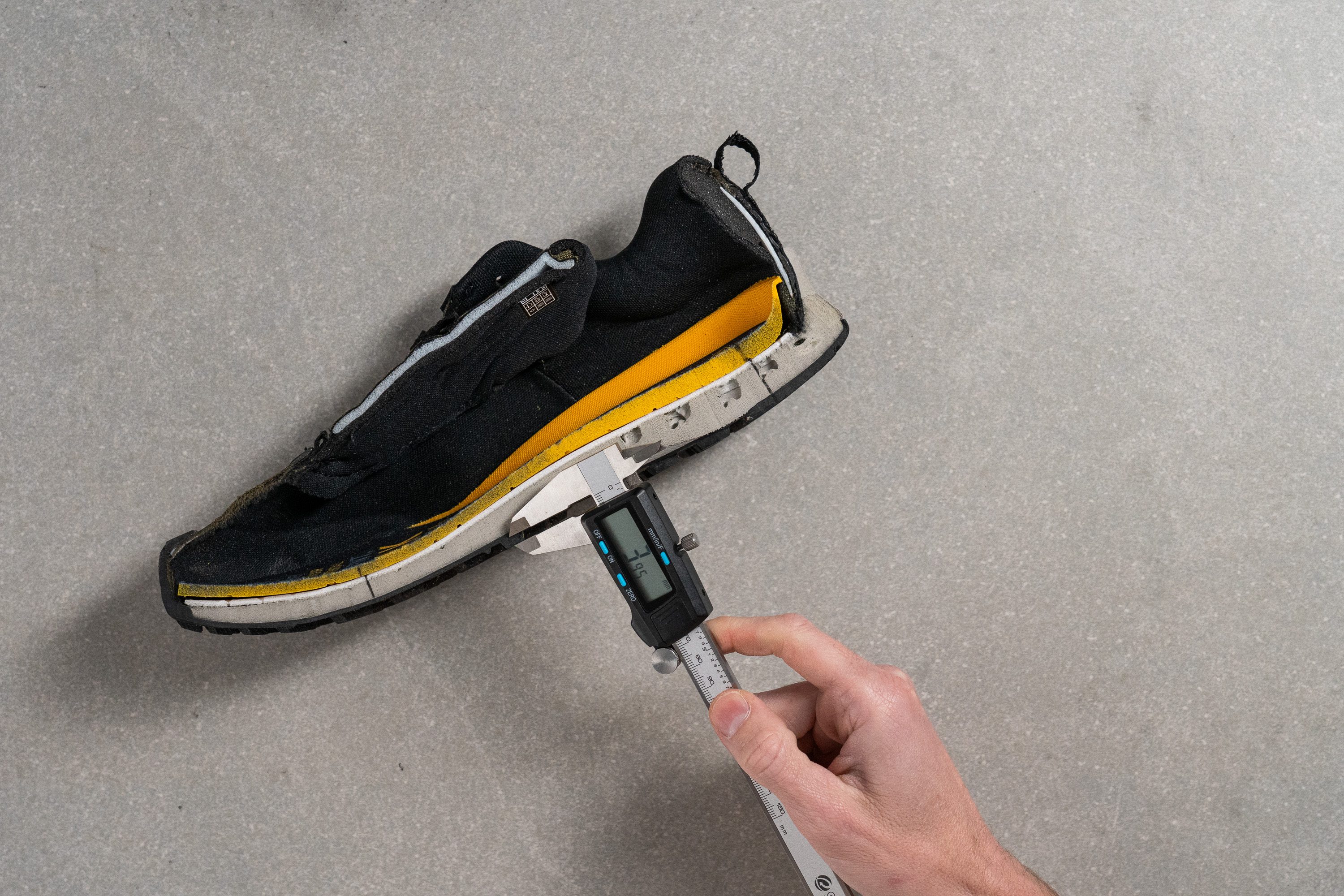
These are aggressive and grippy enough to bite into and provide excellent traction over a variety of surfaces, wet or dry.
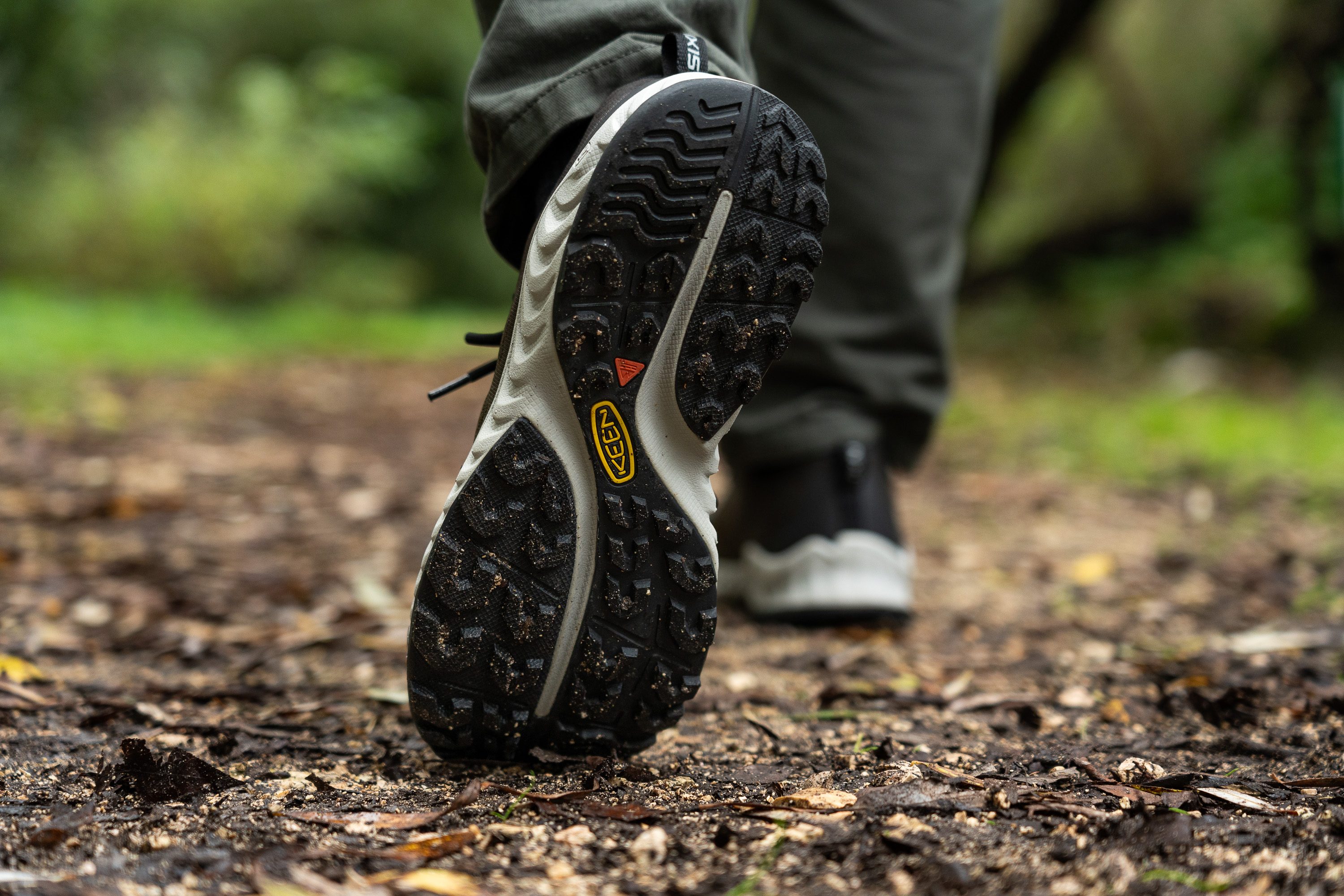
| NXIS Speed | 4.0 mm |
| Average | 4.0 mm |
Flexibility / Stiffness
We secured the NXIS Speed to our workbench and found that only 15.5N of force is needed to bend it 90 degrees. This is much more flexible than the average hiking shoe, allowing the NXIS Speed to conform with the natural flexion of our foot with ease throughout our stride.
This further explains the NXIS Speed's natural and forgiving ride that feels easy on the foot for as long as we have the shoe on.
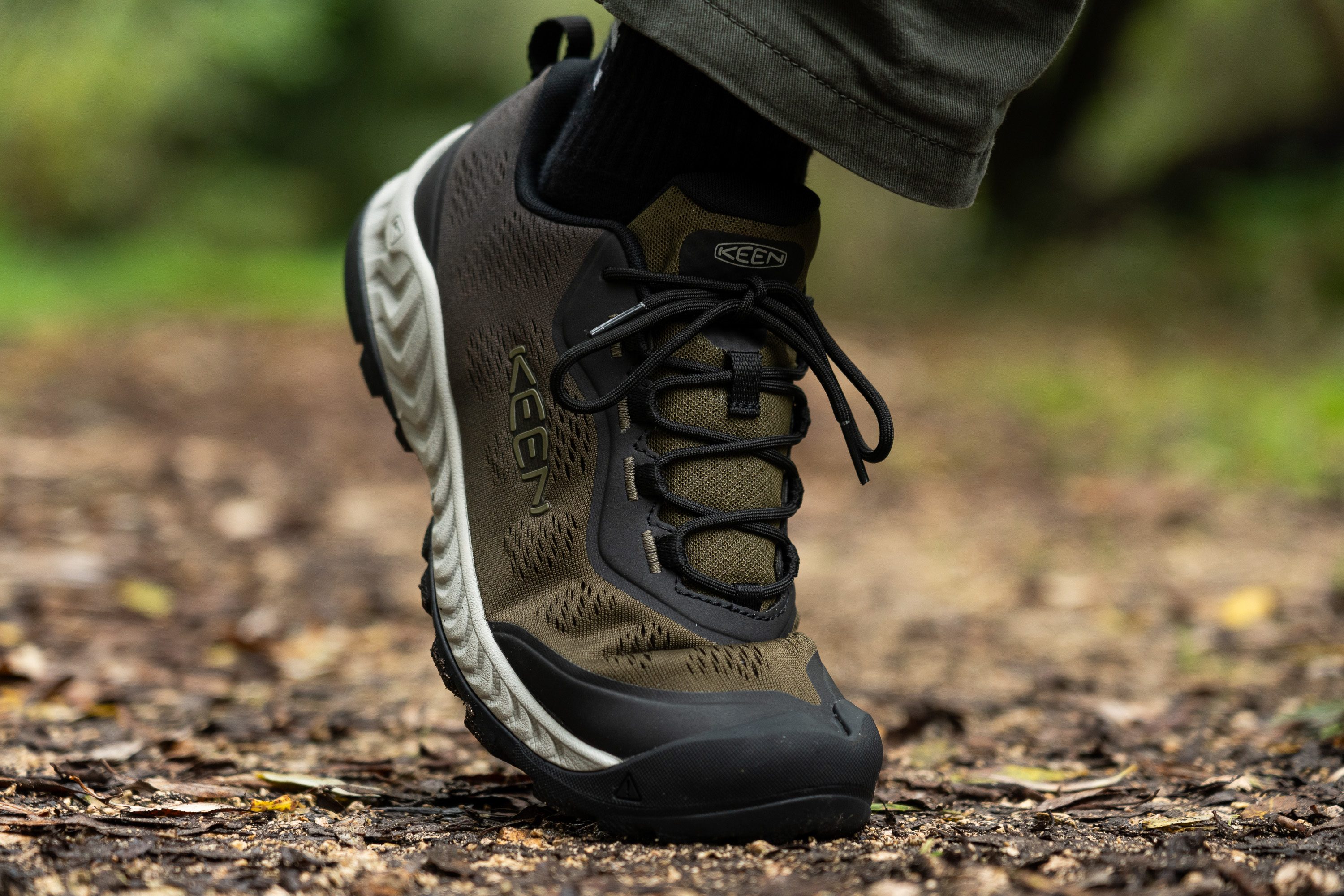
This test follows an older methodology, which is why you don't see recently tested shoes in the chart. Results from different methodologies can not be compared.
| NXIS Speed | 15.5N |
| Average | 29.6N |
Stiffness in cold (%)
As with our previous freezer test, the NXIS Speed performed more consistently than average when we repeated the stiffness test, becoming only 25% stiffer once the shoe was appropriately chilled. With 19.4N now needed to bend the shoe to the desired point, it's more flexible than the average hiking shoe at room temperature. While we still wouldn't recommend it for brutally cold or very wet/snowy expeditions, the NXIS Speed will do just fine during brisk winter hikes.
| NXIS Speed | 25% |
| Average | 28% |
Weight
A big factor in how the shoe lives up to its speedy name is how incredibly light it feels underfoot. This allows us to be swift on our feet as we tackle tricky ascents and keeps us from plodding down heavily on quick descents.
This feathery disposition is borne out on our scale, with the NXIS Speed coming in at a significantly lighter-than-average 11.8 oz (335g).

| NXIS Speed | 11.8 oz (335g) |
| Average | 13.4 oz (380g) |
Breathability
To get a visual idea of how well-ventilated the NXIS Speed is, we pumped the shoe full of smoke in our breathability test. The result is a rather mesmerising image of plumes of smoke wafting through all areas of the shoe like snakes being charmed out of their baskets. This impeccable performance earns the NXIS Speed a perfect 5 out of 5 for breathability, making it a great choice for those warm summer hikes. With this level of airflow, the shoe should dry up pretty quickly if submerged for one reason or another or after a particularly sweaty trek. As such, stinky feet won't be an issue with the NXIS Speed.
Contrary to our expectations, the NXIS Speed blocked out most of the light when we inspected a backlit cross-section of its upper. Only the perforated portions of the upper mesh allowed any sliver of light to peek through. This would ordinarily indicate below-average to mediocre breathability at best but goes to show that there are exceptions to all rules.
Looking at the NXIS Speed's upper mesh under our microscope clears things up a little better.
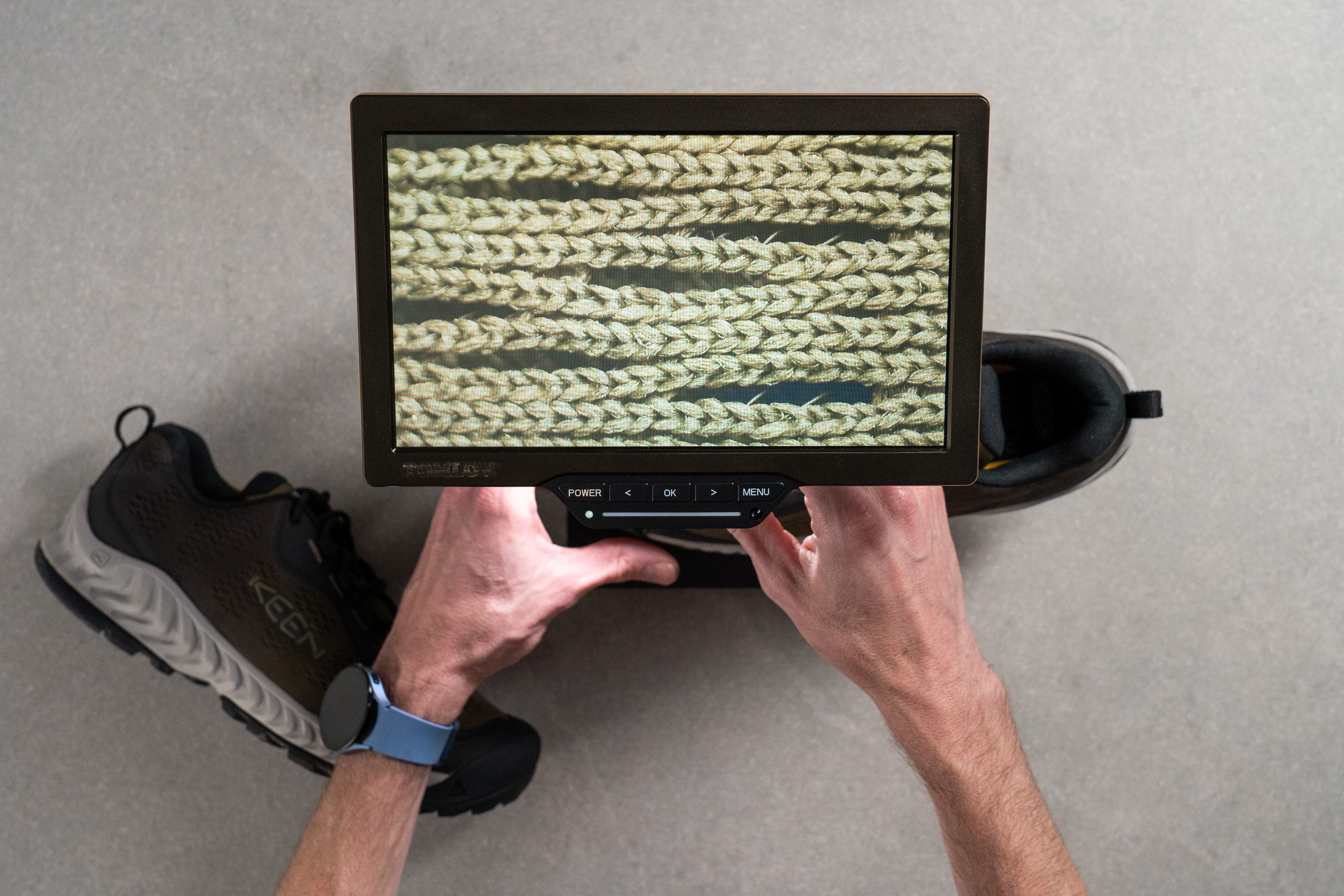
While the braids are dense enough to block out the light, they are woven to form a pattern of gaps that reveal a much airier underlayer of mesh that clearly provides ample airflow throughout the shoe.
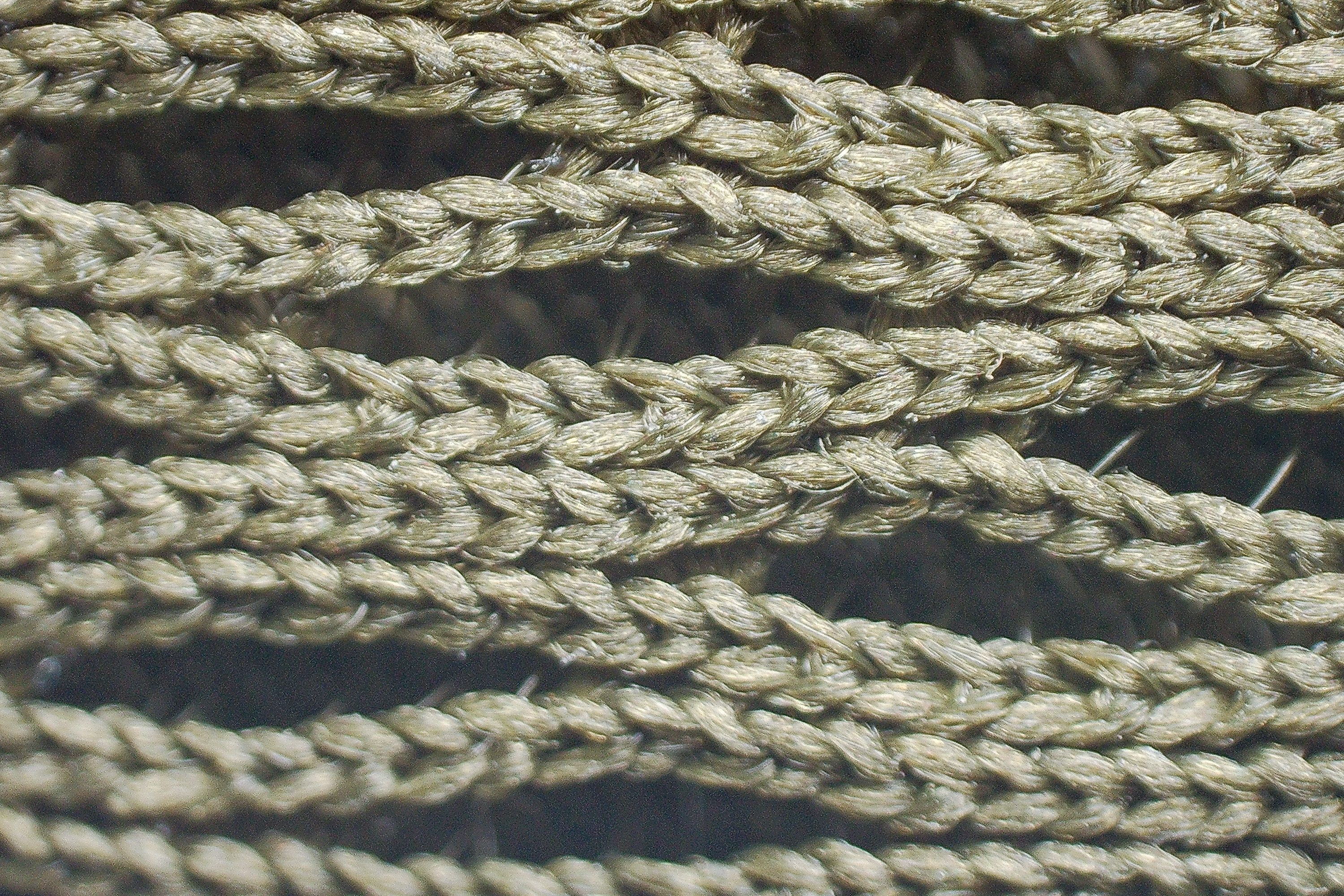
| NXIS Speed | 5 |
| Average | 2.4 |
Stability
Lateral stability test
While a soft midsole doesn't usually bode well regarding a shoe's stability, we were pleasantly surprised with how stable the NXIS Speed felt as we shifted our weight from side to side.
This feels balanced enough to take on easy to moderate trails, though we wouldn't recommend attempting anything too challenging or going too far off the beaten path with the NXIS Speed.
Torsional rigidity
The NXIS Speed didn't put up much resistance as we bent and twisted the shoe in our hands, leading us to give it a torsional rigidity score of 2 out of 5. This doesn't contribute to the stability of the NXIS Speed as much as it helps make the shoe feel quite comfy and natural underfoot.
| NXIS Speed | 2 |
| Average | 3.7 |
Heel counter stiffness
The heel counter, on the other hand, earns a perfect 5 out of 5 as we were barely able to get it to budge during our manual assessment. This serves to effectively lock our heels in place and mitigate any excessive rolling in our gait that might lead to instability in our stride.
| NXIS Speed | 5 |
| Average | 3.7 |
Midsole width - forefoot
The NXIS Speed's midsole isn't quite as broad as our current lab average at only 103 mm wide at the forefoot. Nevertheless, it still provides a good surface area of grippy lugs to keep us feeling surefooted during our stride.
| NXIS Speed | 103.0 mm |
| Average | 111.3 mm |
Midsole width - heel
The midsole is also a little shy of our lab average at the heel, measuring 84.8 mm wide according to our caliper.
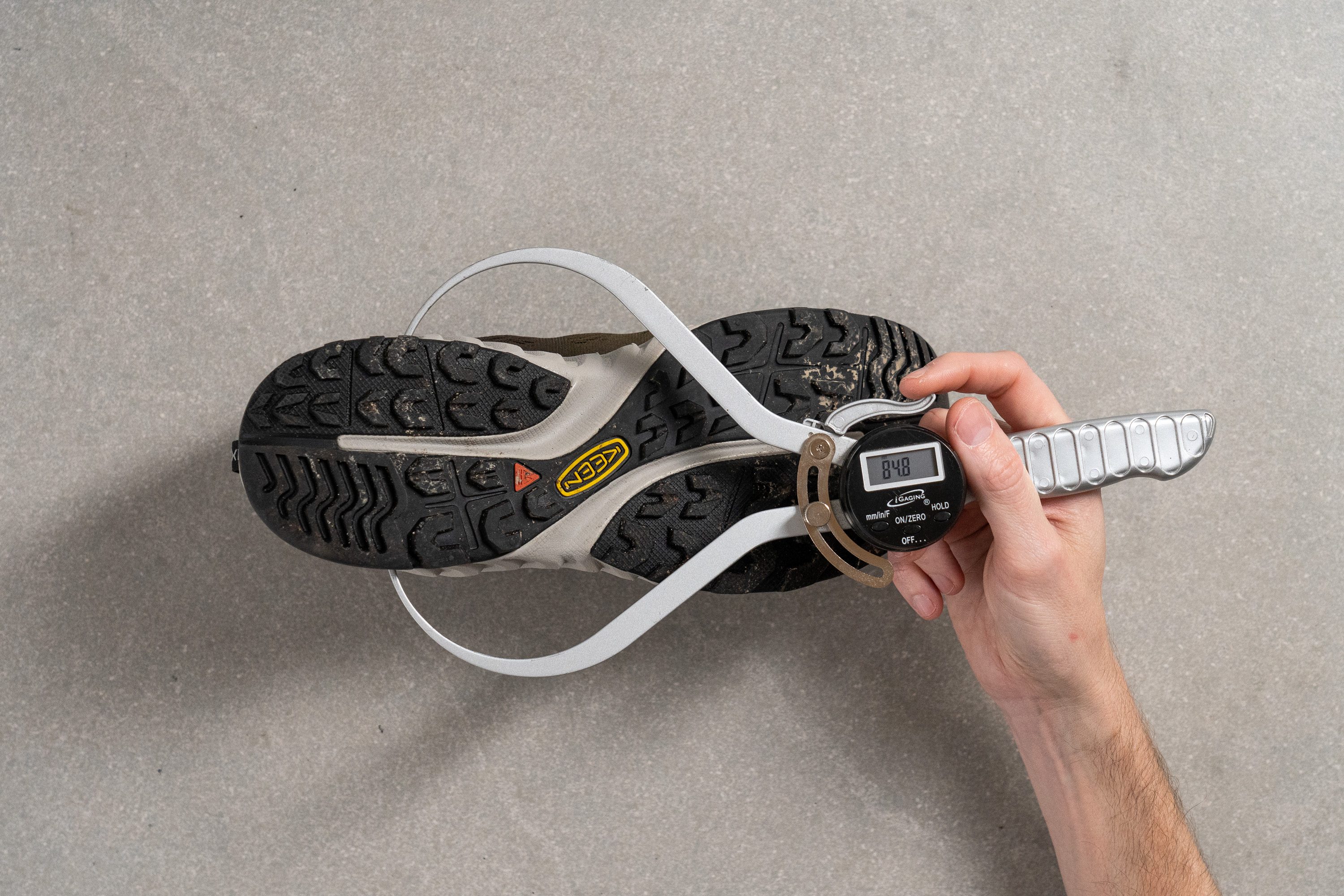
| NXIS Speed | 84.8 mm |
| Average | 87.9 mm |
Durability
Toebox durability
Durability is key when it comes to hiking shoes and the NXIS Speed is equipped with overlays and a rubberized toe bumper to protect its upper mesh from hazards on the trails. We applied our Dremel to a partially protected portion of the toebox mesh to see just how hardy it is.
After twelve seconds of seemingly brutalising the shoe, we found that our tool hadn't actually done much damage to the NXIS Speed's toebox. As a result, we give it a toebox durability score of 4 out of 5. This means that we can confidently traverse the trails without worrying about snagging and tearing through the upper mesh.
| NXIS Speed | 4 |
| Average | 3.7 |
Heel padding durability
Next, we turn our attention to another vulnerable area of the shoe; the heel collar. Our Dremel makes quick work of the lining and kicks up a flurry of debris.
However, with the NXIS Speed's heel counter being as robust as it is, we found that there was still quite a fair amount of padding left over after the four-second test was up. This leads us to give the NXIS Speed a heel padding durability score of 3 out of 5. An average performance like this doesn't give us much cause for concern with normal use over the lifetime of this shoe.
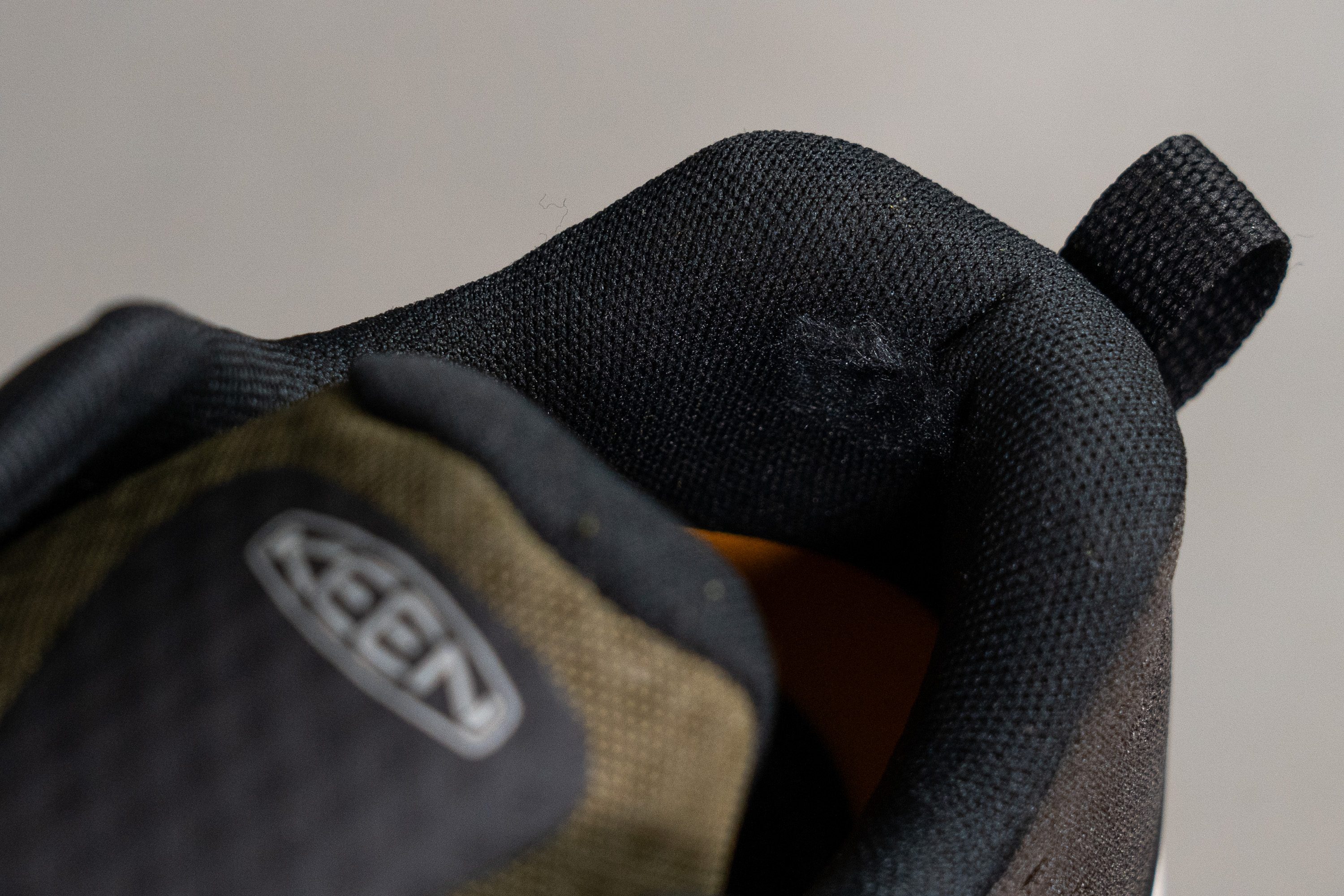
| NXIS Speed | 3 |
| Average | 3 |
Outsole hardness
Pressing our durometer against the NXIS Speed's outsole yields a slightly softer-than-average reading of 80.5 HC. This should still be hard enough to provide a good balance of durability and grip.
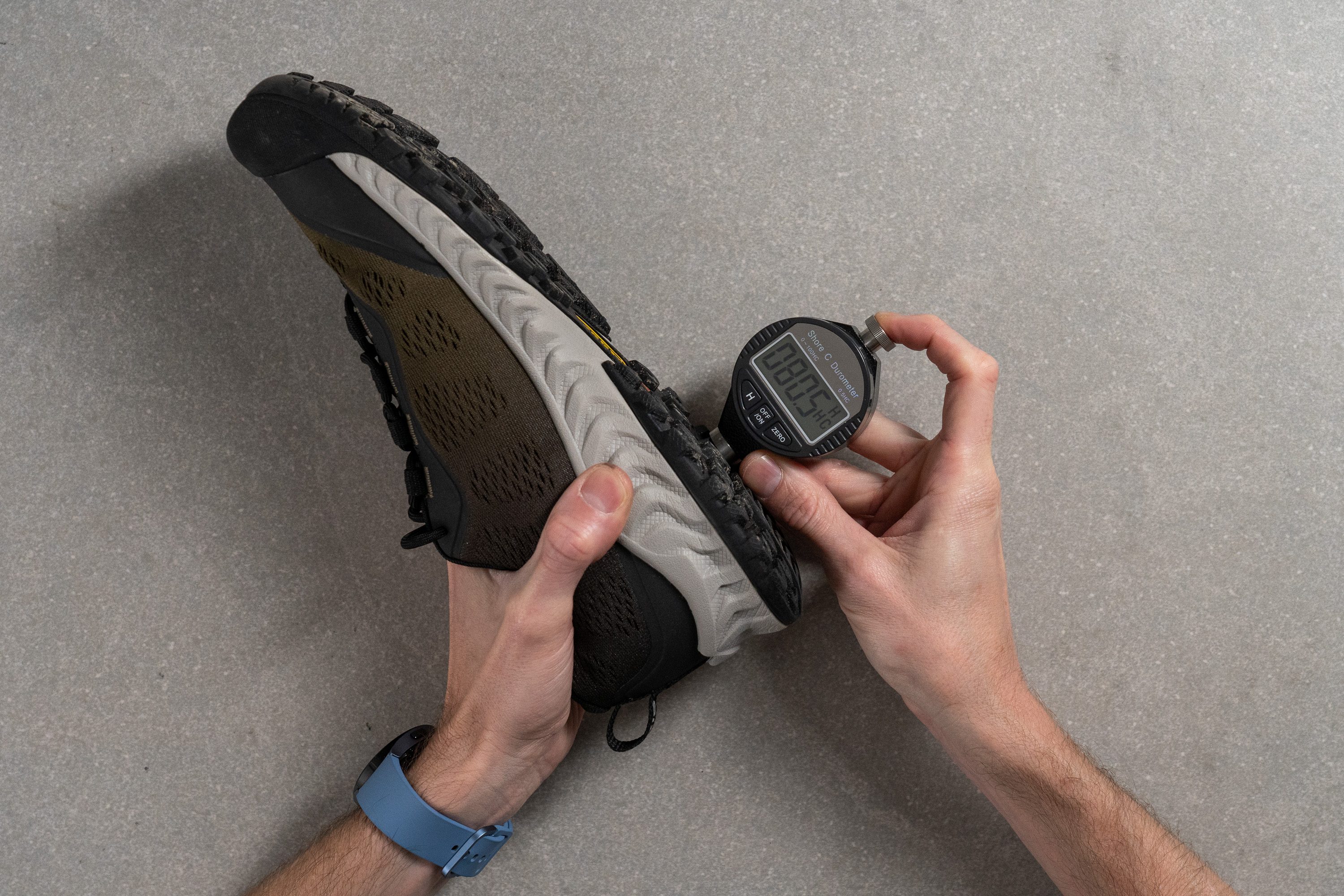
| NXIS Speed | 80.5 HC |
| Average | 85.1 HC |
Outsole durability
We fired up our Dremel one last time to 10K RPM and applied it to one of the NXIS Speed's lugs with 3.2N of force. This seems to have little effect on the shoe as our tool's grinding element isn't able to bite into the rubber very well over the course of the twenty-second test.
Using a tyre tread gauge to assess the damage, we found that only 0.5 mm of material was shaved off the lug. This is less than half of what the average hiking shoe loses, making the NXIS Speed's outsole extremely durable even in the face of extreme wear and tear. With a total of 7 mm of rubber to go through, we expect the NXIS Speed to last well beyond 500 miles of hiking before showing any real signs of damage on the outsole.
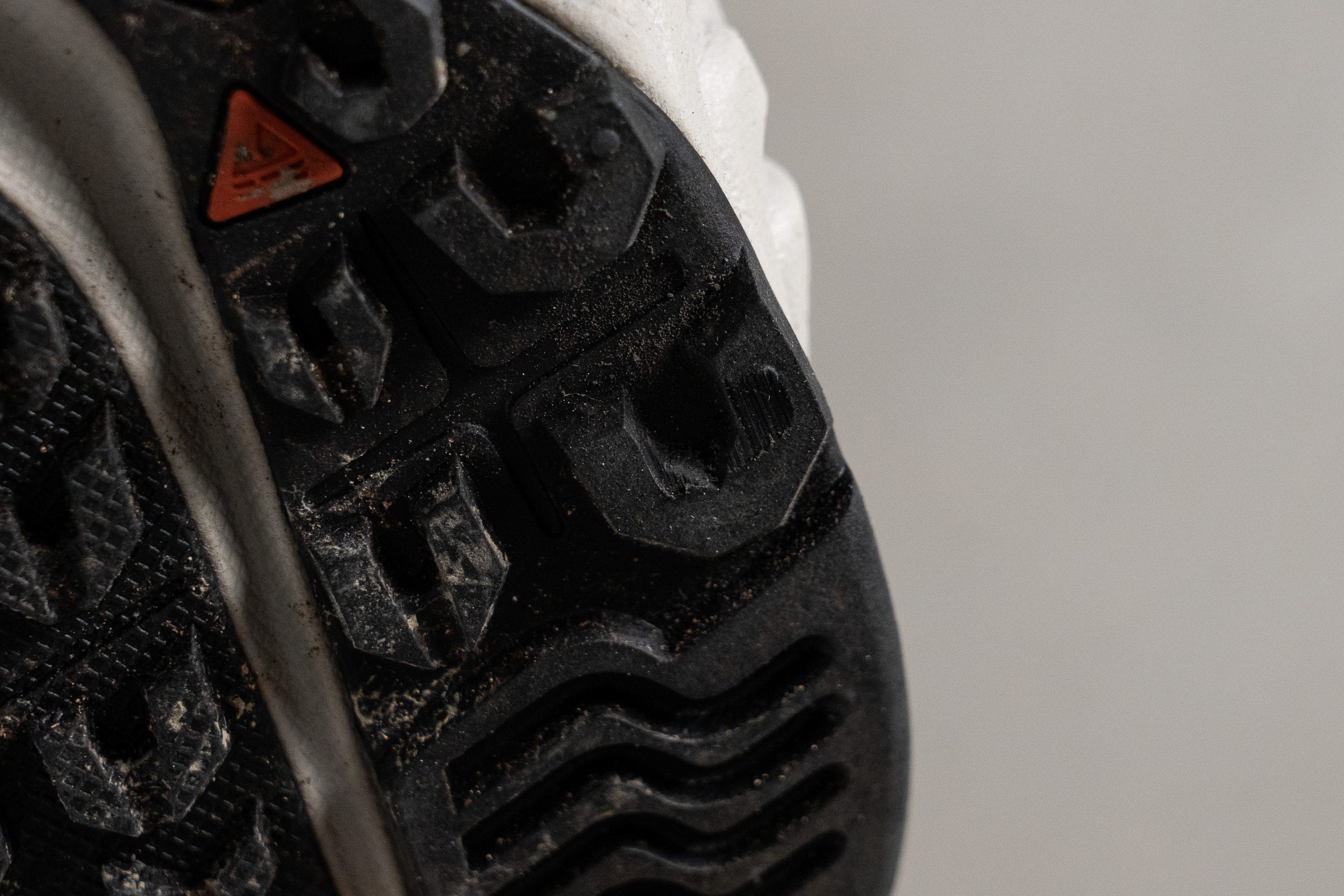
| NXIS Speed | 0.5 mm |
| Average | 1.0 mm |
Outsole thickness
With 3 mm of rubber making up the outsole according to our caliper measurements, the NXIS Speed falls in line with our current lab average.
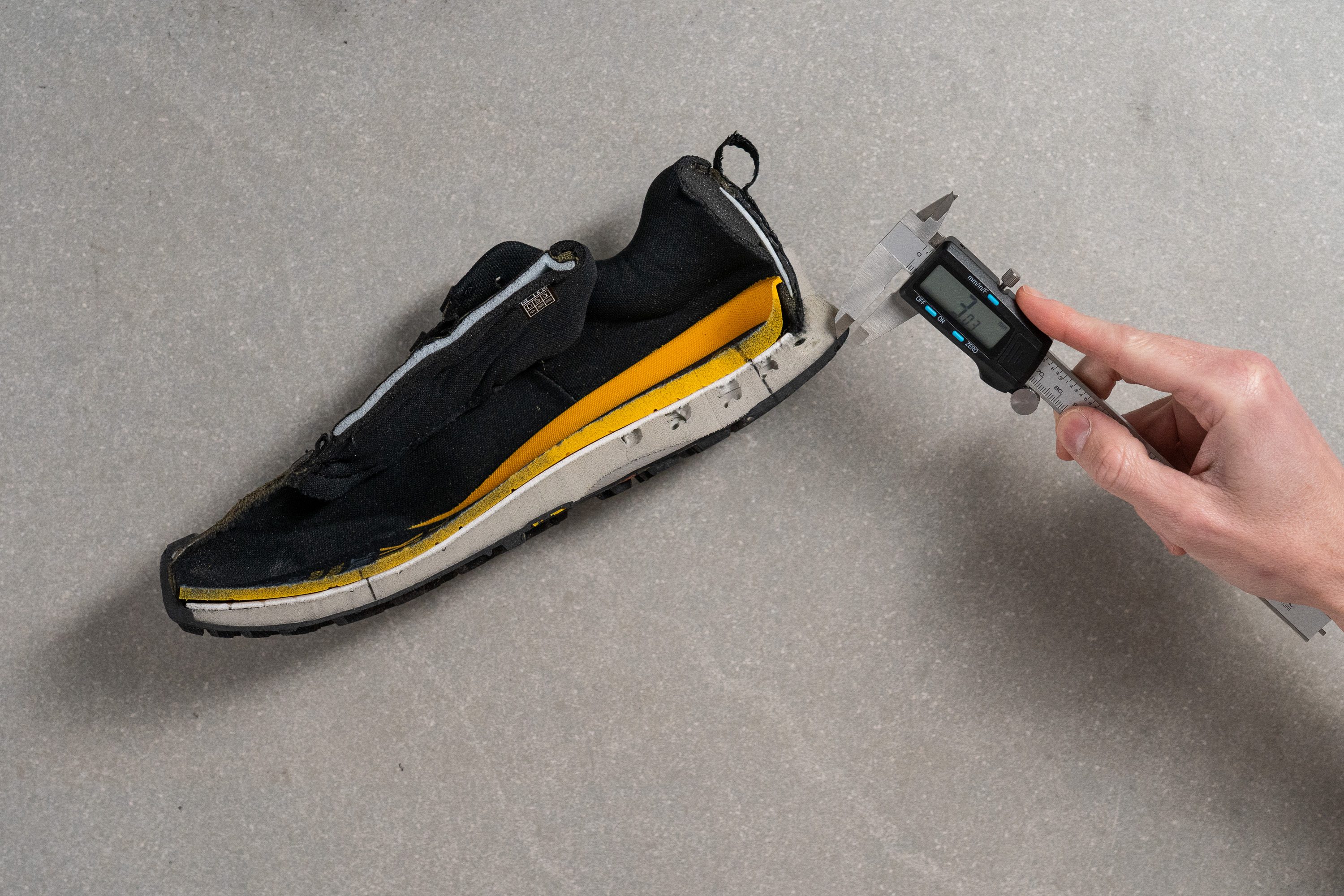
| NXIS Speed | 3.0 mm |
| Average | 2.5 mm |
Misc
Insole thickness
Further contributing to the NXIS Speed's incredibly soft and forgiving ride is its chunky insole which we measured to be 8.2 mm thick. This gives us a luxuriously well-padded and supportive landing surface within the shoe that complements the midsole cushioning extremely well. Fallen arches were the furthest thing from our mind while testing this shoe.
| NXIS Speed | 8.2 mm |
| Average | 5.3 mm |
Removable insole
The NXIS Speed's chunky insole is removable, so those in need of custom orthotics can use them with this shoe.
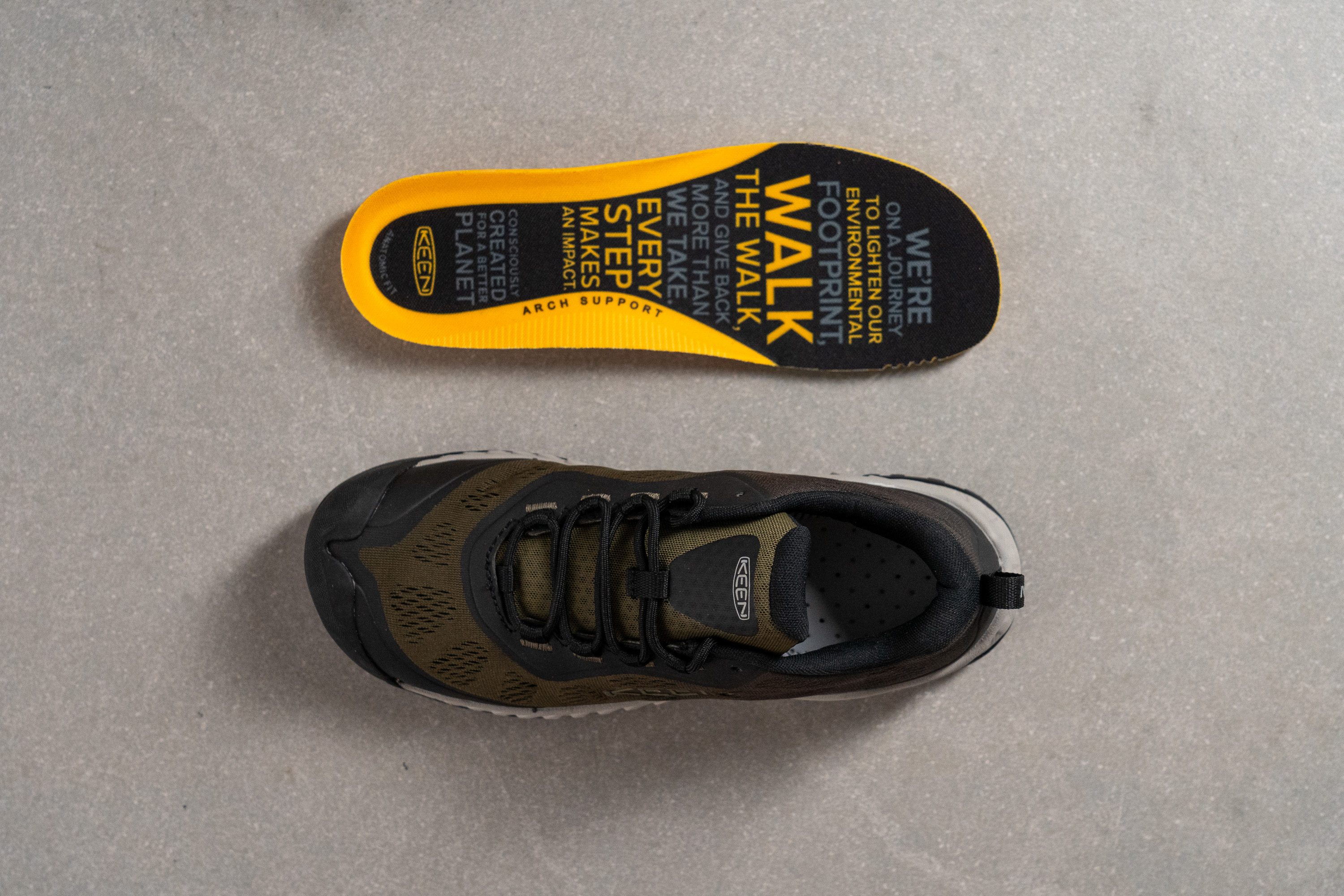
| NXIS Speed | Yes |
Midsole softness in cold
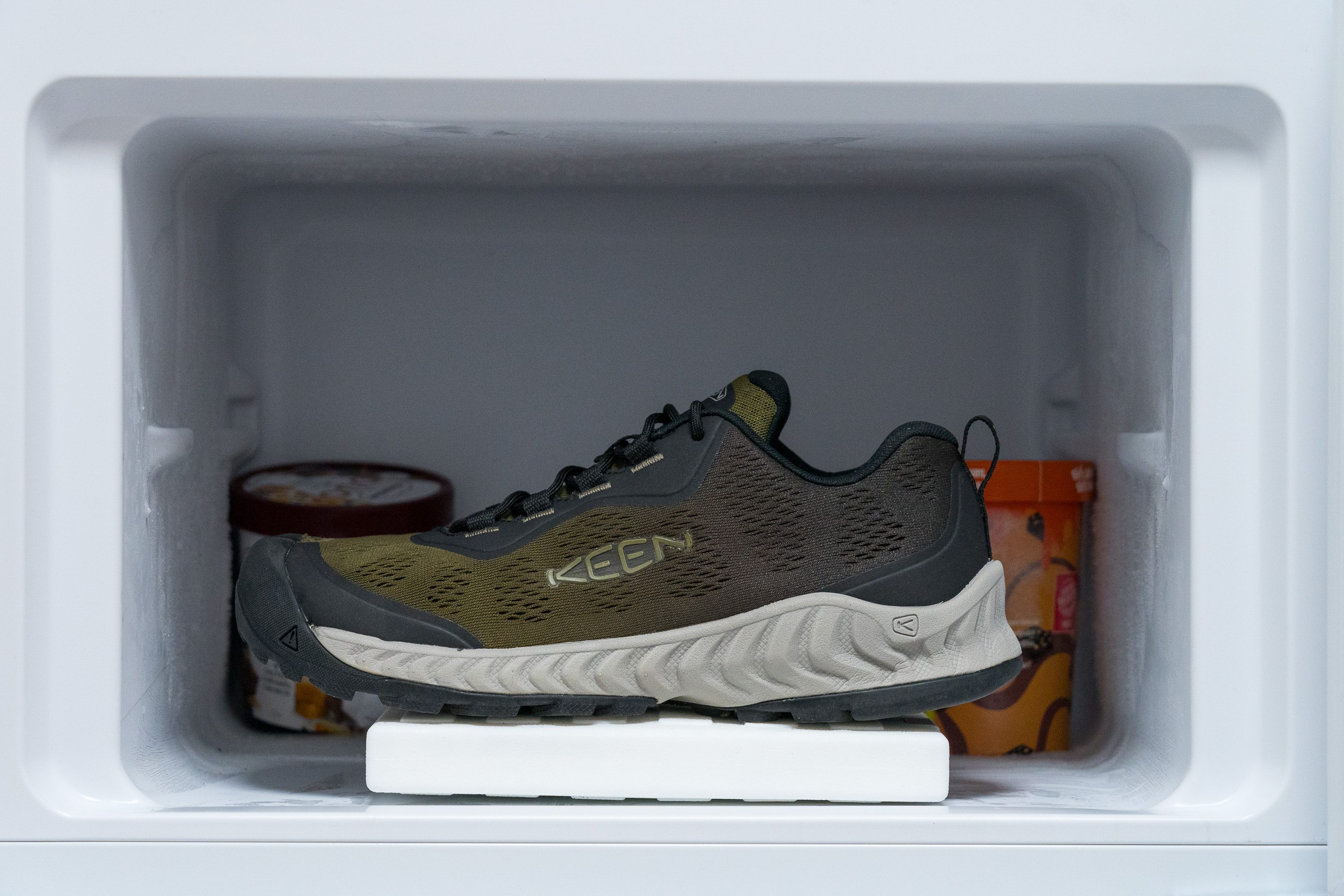
Midsole softness in cold (%)
Despite being more well-suited to warm hikes, the NXIS Speed's midsole performs incredibly well in cold conditions. After leaving the shoe in our freezer to chill for twenty minutes, we found that its midsole only became 7.8% firmer; making it much more consistent than the average hiking shoe as the weather changes. Furthermore, with a durometer reading of 22.5 HA, the NXIS Speed's midsole remains softer than the average for hiking shoes at room temperature. As such, the NXIS Speed should feel just as well-cushioned and comfy underfoot during winter hikes, given it's paired with a pair of warm socks.
| NXIS Speed | 8% |
| Average | 19% |
Reflective elements
With no reflective elements to be found on the shoe whatsoever, we don't recommend hiking along badly-lit roads at night in the NXIS Speed without using additional high-vis gear.
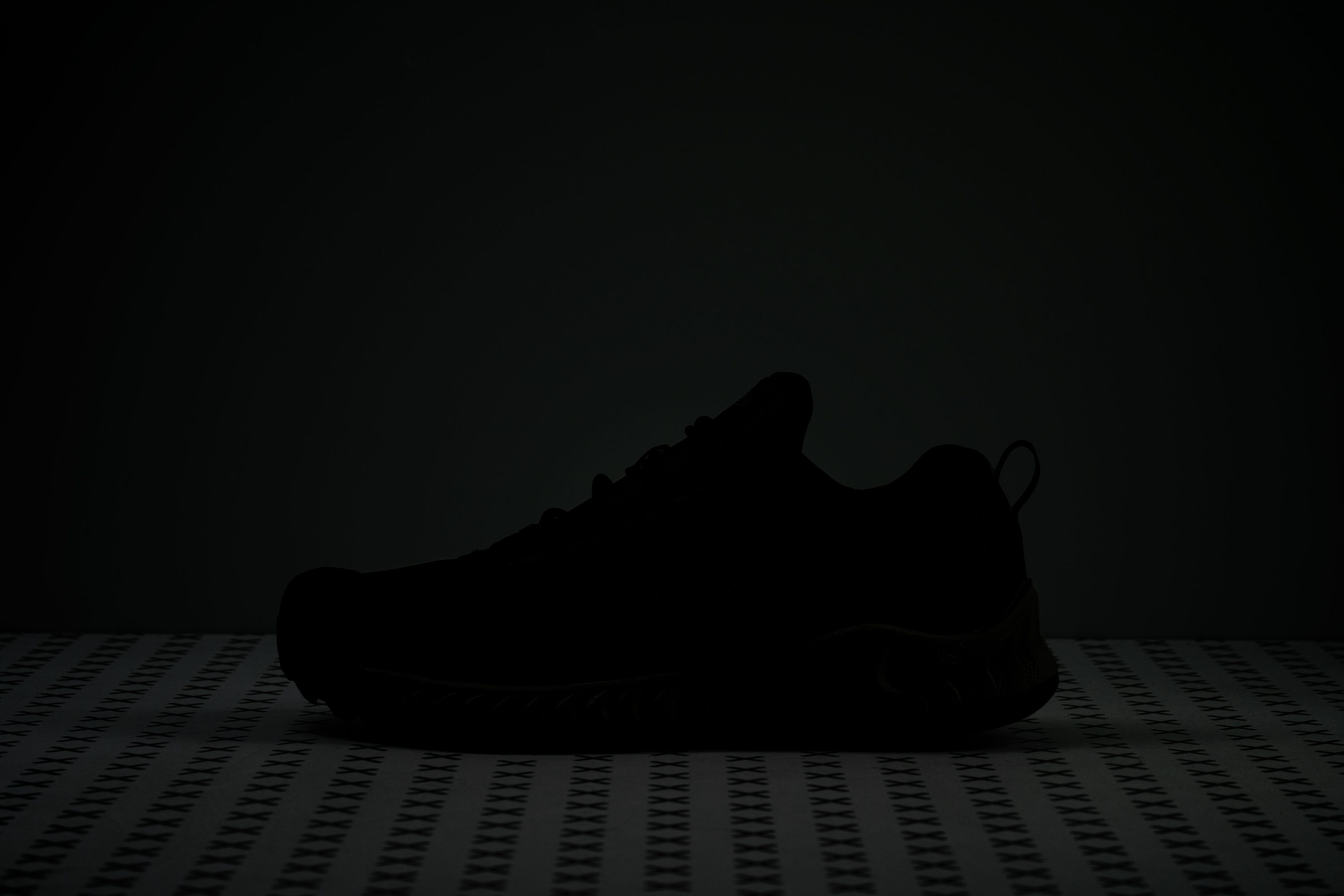
| NXIS Speed | No |
Tongue padding
We measured the NXIS Speed's tongue to be 8.5 mm thick according to our caliper. While this is a little shy of our current lab average, it still provided us with excellent comfort across the instep and effectively protected us from lace bite no matter how tightly we laced up the shoe.
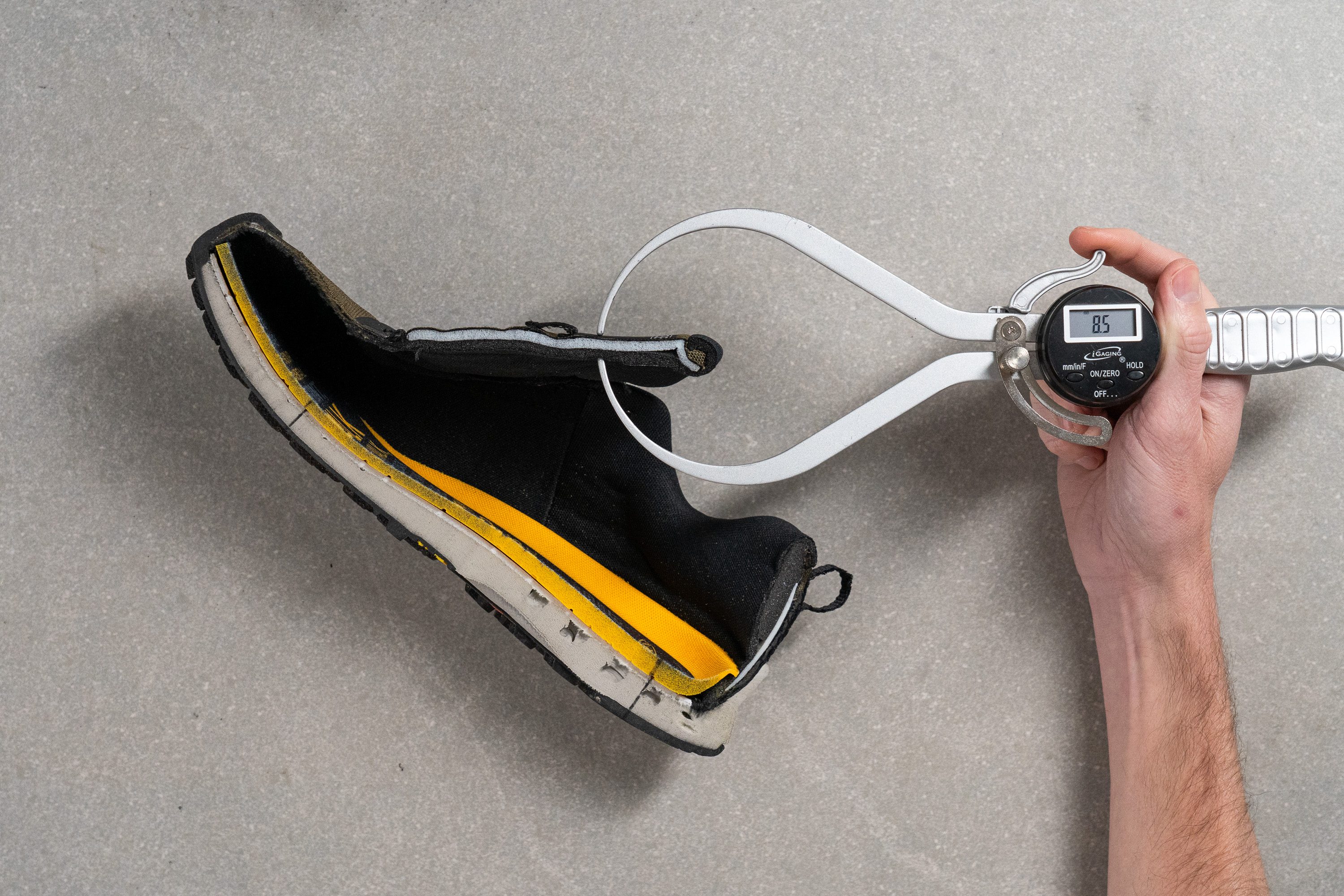
| NXIS Speed | 8.5 mm |
| Average | 10.2 mm |
Tongue: gusset type
The NXIS Speed's tongue is non-gusseted. On the one hand, the omission of a gusset does serve to keep some weight off the shoe, it does, on the other, mean that we did have to contend with the occasional bit of debris making its way into the shoe during our test hikes.
| NXIS Speed | None |
Heel tab
The NXIS Speed features a handy finger loop at the heel to facilitate sliding the shoe on quickly and smoothly.

| NXIS Speed | Finger loop |

